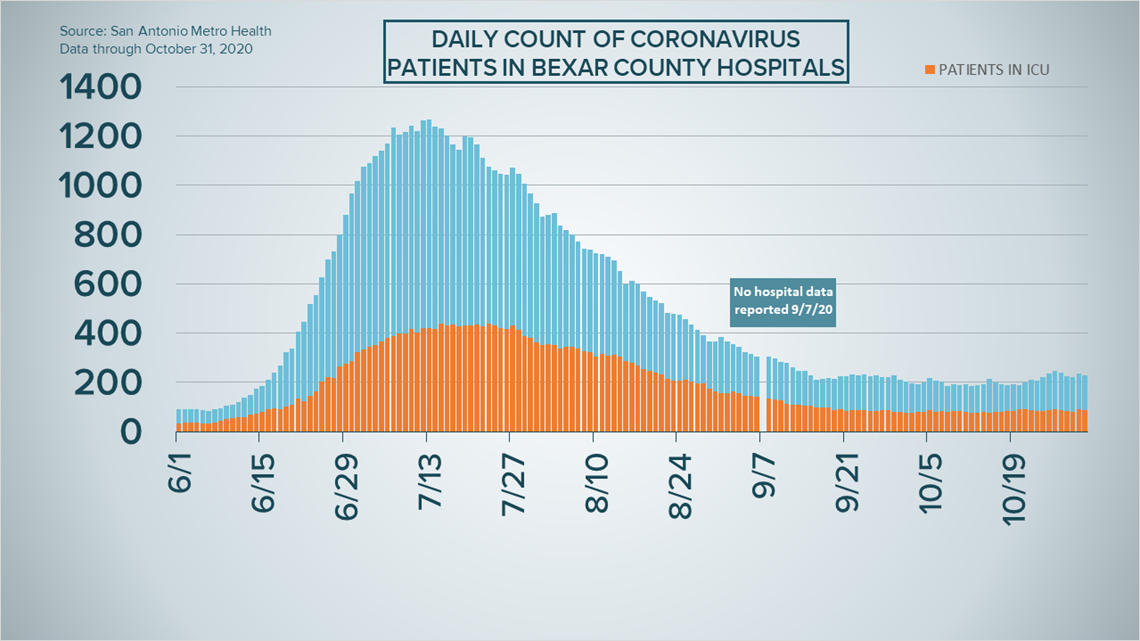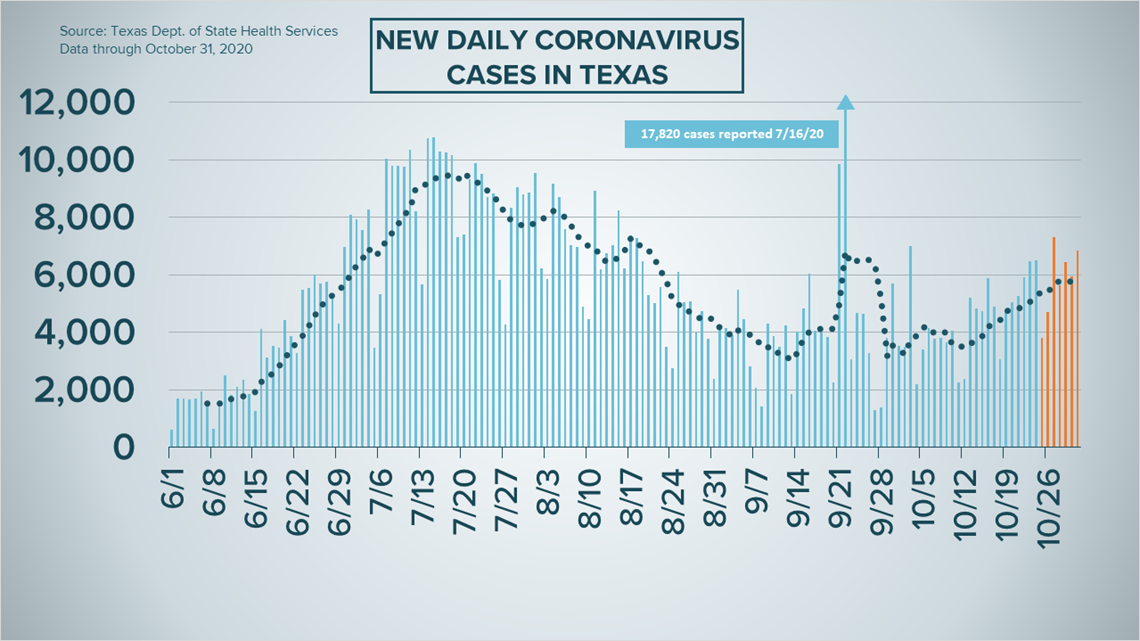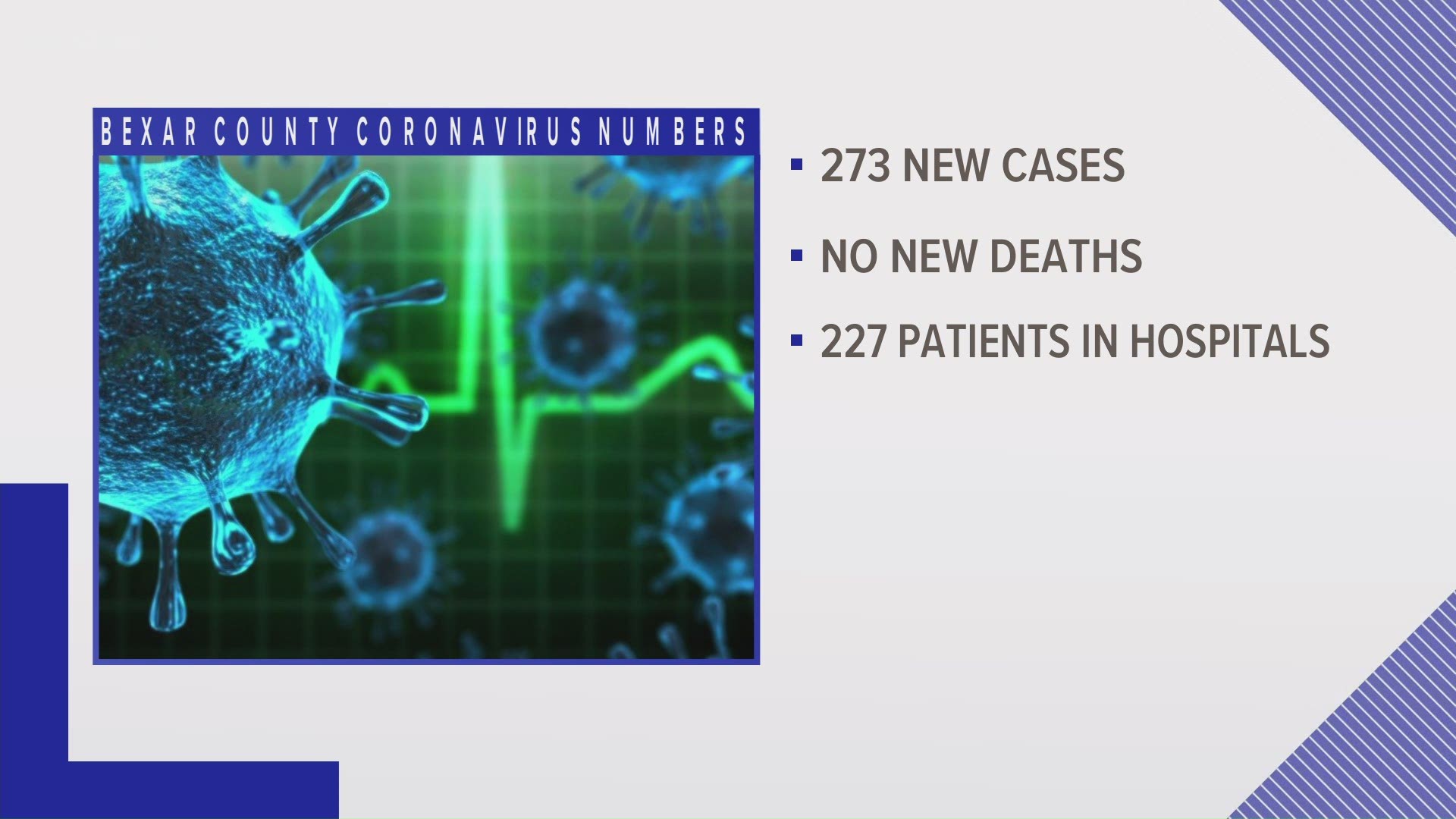SAN ANTONIO — We're tracking the latest numbers from the coronavirus pandemic in San Antonio and across Texas. Here are the latest numbers reported by Bexar and surrounding counties:
- Bexar County: 273 new cases were reported Saturday, bringing the total number of cases for the county to 65,873. No new deaths also reported, so the death toll remains at 1,251.
- Comal County: The county reported 12 new COVID-19 cases Friday morning. No new virus-related deaths were reported. There have been a total of 3,776 cases of COVID-19 in the county – including 2,878 lab-confirmed cases – while 120 county residents have died. County officials say there are 116 active coronavirus cases, and 3,540 residents are considered recovered.
- Hays County: Officials in Hays County on Friday reported 13 new cases in the county and no additional virus-related deaths. As of Friday, there are a total of 6,132 lab-confirmed cases in the county (323 of which are active), and the death toll remains at 87. 5,722 residents have recovered from the virus.
How Bexar County is trending
We've tracked how many coronavirus cases have been confirmed in Bexar County from the time officials began reporting cases in March 2020. The graphic below shows the number of cases since June and charts those daily case numbers along a 7-day moving average to provide a more accurate picture of the overall coronavirus case curve in our area and the direction we're trending amid the pandemic.
On Saturday, Metro Health updated its online coronavirus dashboards to reflect an additional 273 novel coronavirus cases for Bexar County, the most since Wednesday's 281. The county reported 8,041 cases in October, which accounts for 12.2% of the total.
There have been at least 65,873 COVID-19 infections in our area during the ongoing pandemic.
Health authorities say there are no new deaths from virus complications; 1,251 Bexar County residents have died from COVID-19 in all.


Hospitalization figures are lower than they were on Friday. Eight fewer patients were receiving treatment for COVID-19 symptoms on Saturday, for a current total of 227. The numbers of patients using ventilators (58) is eight more while the number of patients in intensive care (88) is four fewer.


Coronavirus in Texas
The number of Texans who have tested positive for the coronavirus since the pandemic began grew by 7,145 on Saturday, according to the Texas Department of State Health Services.
6,845 of those are new diagnoses over the last 24 hours, while another 300 cases stem from a number of backlogs in several counties. More details can be found at the top of this page.
The state on Saturday surpassed 900,000 COVID-19 infections, just 18 days after reaching 800,000 as the virus's spread quickens in the Lone Star State. In all, at least 900,596 Texans have contracted COVID-19.


State health authorities also reported 90 additional virus-related deaths on Saturday. At least 18,024 Texans have passed away from COVID-19 complications.
Meanwhile, COVID-19-related hospitalizations in Texas increased again, with 5,696 Texans receiving treatment for COVID-19 symptoms—69 more patients overall than on Friday.
October saw a reversal of the previous two months' positive trends pertaining to the COVID-19 situation in Texas, including lower hospital admissions and case numbers. Those trends reversed this month as October ends with 79% more current hospitalizations than on Oct. 1. Health officials warn that the state is currently in another surge. Experts attribute the spike in COVID-19 numbers to "pandemic fatigue."
The state estimates that 782,006 Texans have recovered, while 102,769 Texans remain ill with COVID-19.
Meanwhile, the Texas Education Agency updated its online coronavirus database to show that there have been 26,127 cumulative cases among staff and students across the state through Oct. 23. More information can be found here.
The TEA releases new data on school cases every Thursday.
Latest Coronavirus Headlines
- Halloween during the pandemic: Costumes and candy, at a distance
- Texas hits 900,000 coronavirus cases, capping a month of resurgent virus spread
- England faces new month-lockdown as UK coronavirus cases pass 1 million
- Why experts say young people are vital to COVID-19 vaccine trials
- US coronavirus cases surpass 9 million as infections rise in 47 states
- COVID-19 vaccine will be free when approved, health officials say
- Thanksgiving feast or famine amid pandemic? Turkey industry left to guess
- Coronavirus dims Mexico's bright Day of the Dead celebration
- Remdesivir study underway by UT Health SA and University Health System
Coronavirus symptoms
The symptoms of coronavirus can be similar to the flu or a bad cold. Symptoms include fever or chills, cough, shortness of breath or difficulty breathing, fatigue, muscle or body aches, headache, new loss of taste or smell sore throat, congestion or runny nose, nausea or vomiting and diarrhea, according to the Centers for Disease Control.
Most healthy people will have mild symptoms. A study of more than 72,000 patients by the Centers for Disease Control in China showed 80 percent of the cases there were mild.
But infections can cause pneumonia, severe acute respiratory syndrome, kidney failure, and even death, according to the World Health Organization. Older people with underlying health conditions are most at risk.
But infections can cause pneumonia, severe acute respiratory syndrome, kidney failure, and even death, according to the World Health Organization. Older people with underlying health conditions are most at risk.
Experts determined there was consistent evidence these conditions increase a person's risk, regardless of age:
- Chronic kidney disease
- COPD (chronic obstructive pulmonary disease)
- Obesity (BMI of 30 or higher)
- Immunocompromised state (weakened immune system) from solid organ transplant
- Serious heart conditions, such as heart failure, coronary artery disease, or cardiomyopathies
- Sickle cell disease
- Type 2 diabetes
The CDC believes symptoms may appear anywhere from two to 14 days after being exposed.
Human coronaviruses are usually spread...
- Between people who are in close contact with one another (within about 6 feet).
- Through respiratory droplets produced when an infected person coughs, sneezes or talks. These droplets can land in the mouths or noses of people who are nearby or possibly be inhaled into the lungs.
- Some recent studies have suggested that COVID-19 may be spread by people who are not showing symptoms.
Help stop the spread of coronavirus
- Stay home when you are sick.
- Eat and sleep separately from your family members
- Use different utensils and dishes
- Cover your cough or sneeze with your arm, not your hand.
- If you use a tissue, throw it in the trash.

